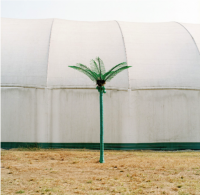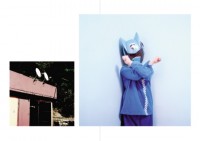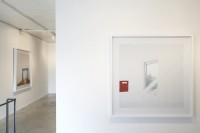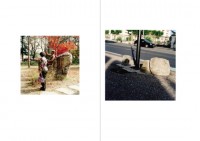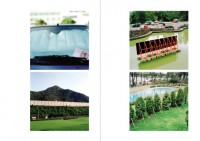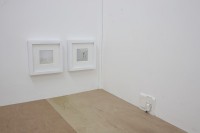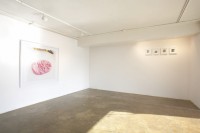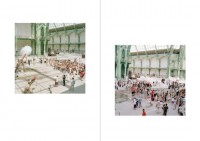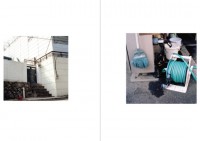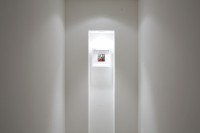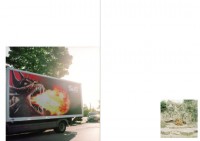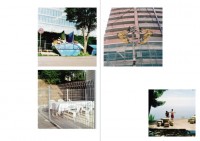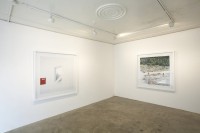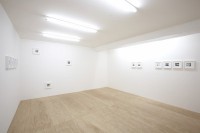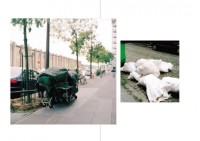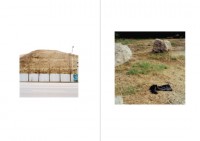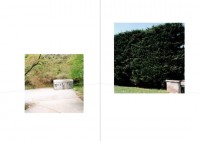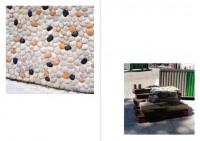Novelles FrontiĂšres
ONE AND J. GALLERY, 2007
Image, Veil and Bricolage On the work of Yum Joog-Ho Kang Honggoo
âLike a photographic artist who moves slowly for his ultimate photograph, I thought how great it would be to have a camera in my head, a camera of insanity, to capture all the scenes. If so, that in itself would be an epic.â - Jack Kerouac, On the Road to Florida with Robert Frank, 1958 How do photographers see the world? Through the camera? No. They first look at the world with their bare eyes. Then they pick up their cameras and look at it through the view finder. After that, of course, they press the shutter. They could press it a second time, but anyway, a single photograph is taken. This is also the case with Yum Joog-Ho. He photographs what he has seen, and picks his works to be exhibited, as everyone does.
The world seen by Yum covers geographic areas from Korea to Europe. The distances are far and the areas vast, but the photographs themselves show few differences. Yum âs photographs do not specially focus on the differences of spaces or cultural differences. They rather avoid the images that represent Europe or Korea. Unless special attention is given, his photographs seem not to indicate specific places. Korea looks like Europe and Europe looks like part of Korea. Of course part of the reason for this is that there are formal consistencies or similarities. His photographs seem to flee from the strict and full compositions and the almost unnecessary depiction of details often seen in recent large scale photographs. Perhaps Yum Joog-Ho also pressed the shutter while he fled, walking or running. He makes the captured objects speak on their own. Meanwhile, Yumâs photographs hide cultural and geographical differences between different continents. Actually he does not try to hide them. Nevertheless, the two landscapes, or the two subjects resemble each other. No, they are made to resemble each other. Of course, making them resemble each other is not the objective. His photographs talk about the state and situation of objects, and ultimately, the perspective of the artist who saw them. He is in the outskirts. At the outskirts of the world, he sees as he holds his camera. He looks into the coincidental structures with almost complete detachment. He looks at them as if he were grazing against them, as if he were not there. Due to the poetic atmosphere that comes from the colors and the brightness of his photographs, they look beautiful. But as Victor Burgin said, âLooking at a photograph for a long period of time causes conflict.
The image, which first gave pleasure, gradually turns into a veil that prevents us from seeing what is hiding beneath.â This is also the case with Yum Joog-Ho âs photographs. The more we look into them, the more we see the wounds engraved inside them. In some cases the wounds are revealed directly, as in cut-off tree stumps, uprooted trees or rotting fruits in the grass. But most of the photographs literally become veils. The electric outlet on the white background, the robot-like garbage truck, the trash bag that resembles a giant condom, the snorkeling equipment hanging on the wall, etc., are beautiful. But they are all a certain kind of veil. The veil makes us think about what is beyond the objects and the surface of the photographs revealing such objects. We know, of course, that beyond the surface of the photograph there is reality, and the system that created the photographic image.
Whatever it is called, we feel a faint pain. It is because we cannot do anything about the reality and the system. Since the pain is a fundamental thing that is revealed through objects, it continuously makes us feel uncomfortable. Because of the uncomfortable images, our gaze goes from one photograph to another as it shakes lightly. As the eyes travel on, we realize that the images, broken on account of the fragmental aspect of the photograph, are connecting among one another. Victor Burgin also said, âIt is not a coincidence that photographs are displayed so that they cannot be seen for a length of time. We treat photographs in a way of glancing by, depending on how much we know. (When an employee of a national art museum used a stopwatch to measure the time spectators spent looking at a single work, he found out that they took an average of 10 seconds-just like the standard length of a scene in a Hollywood film.)â During those 10 seconds, we look at the photographs, connect them, and try to create a narrative structure. Yumâs photographs do not have a definite narrative structure. They rather repeat separate short pieces. As they are repeated, differences are generated. As the differences and repetitions are repeated the boundaries between the photographs are erased. To say it in the way of Derrida, difference, of which the ends cannot be seen, are created continuously between the images. Thus, his photographs do not explain or indicate the world, but make it boundless. Yum Jung-Ho stands behind the camera as if he does not know how to read the world. This combines with calculated
spectatorial perspective to create the detached attitude. Definitely it is a strategy. The strategical detachment, and the composition method that looks like the photographs were just taken of coincidentally encountered objects makes us ask ourselves what was the photograph, and what is the photograph. To quote from Levi-Strauss, the photograph resembles the way primitive people think-science of the concrete. He says science of the concrete is mythological thinking, and mythological thinking is positioned in between percept and concept, while being tied to the image. Though it only appears to us in the form of the image, it has the capability to generalize, and therefore can be scientific in its own way. According to this logic, since a photograph is an image, it is between percept and concept, and is part of mythological thought. The point between percept and concept is a state prior to abstraction. Therefore photographs are concrete. Of course, concreteness is a characteristic of the photograph, which has long been pointed out. Sometimes it is mentioned in relation with the details or expression methods of the photograph, but actually, the concrete nature of the photograph does not mean how similar it is to an object, or how formal depiction is achieved. Those are side issues, and the more important issue is the method of approaching objects and subjects, in other words, it is an issue of perspective. In the context of Levi-Strauss, the concreteness of photographs is decided according to the perspective of the photographer-what is worthy of documentation, and what is worthy of seeing and reconsidering. This is similar to the way indigenous people in various parts of the world have quite accurate knowledge about plants, but still taste, smell and observe new plants. Like the indigenous tribes, Yum Jung-Ho observes the unnoted concreteness in different continents with his camera. This results in categorization, like the science of the concrete. Of course the categories are not those of science, but those of the bricolage.
It is a known fact that bricolages do not undergo precise planning or a strict production process. Something is made in an easy way, using objects easily obtainable from oneâs surroundings, and given tools. And the original objects are transformed and put into a new category. This is also how Yumâs photographs work. The subjects he takes and makes into images are categorized, crossing over region and time. What can we call such boundaries? What was he trying to say through them? A photograph is a metonymy of the world. Yum Jung-Ho uses .
unintentional bricolages created by trivial objects to show the world Therefore, Yumâs photographs are a dual bricolage. They are dual in the sense that the primarily and coincidentally bricolaged world is made into images with the same attitude. In the process, the effect is also amplified. The world of photography taken by Yum Jung-Ho is chaotic and full of spontaneity. Weeds grow under a parked car, a boxing match takes place like a show in a plaza, the glistening silver-decorated knife is stuck in a pear cut in half. And as I said earlier, this bricolage, the world that produced the metonymy, is silent. The world with a veil cannot be unveiled no matter how much it is photographed. All one can do is document the brief shaking of the veil.
Someone once said, âScience cannot tolerate disorder. It does not matter whether it is natural or cultural science. Scientists endure uncertainty and despair. That is because they cannot do anything about it. But one thing they cannot and must not endure is disorder. The effort to get rid of disorder began unconsciously from a low dimension along with the origin of life.â But photography is not science, and therefore does not bestow order on the world. No matter how formally the images in the frames are organized, that is not order. That order is just the form of the images, and not the order of the world. Even if they are put on the wall in an exhibition space, the result is the same. The photographs hanging on the visually sanitized white wall are just well-organized images. They are not the order of the world.
The same thing can be said about Yum Joog-Hoâs works. Standing, or walking with the camera, he sees the coincidence, or the wirepuller of the coincidence, created by the disorder. He probably enjoys it. In order to capture the fragments faintly in the photograph⊠No, the photographer just responds to the images with his camera. And he tosses the ball to the spectators, concerning how to read it or how to respond and interpret it. Whether it takes one second or ten seconds to see and seconds to see and interpret the photograph, he does not care.
The photographer merely holds his camera and documents the fragments Of the concrete world instantly.
Joongho Yum
A sad comedy
Just thinking about my own work makes me feel as if I come across someone I am trying to avoid at a dead end street. This is not to say I do not want to talk about it. Rather, I want to keep away from itâ the thing to give a visual or linguistic form to the indistinct. I once used to condemn artists who were unable to provide a clear description of their works, for I believed that an artist who did not know what he or she had done would be really pathetic. However, in 2005, around the time when I began this body of works, I decided to give up any predetermined concept or idea in producing images. Artists are inspired by many things. And I think I myself have been influenced by works of many of my favorite artists. Nevertheless, it was only several principles that I had in mind when I began this project: First, donât be possessed by any concept. Second, donât make my photographs into a series. Third, look for objects which will occupy my eyes (or mind). Of course, they can neither draw attention from other people nor can be understood by them. Yes, but artists always suffer from the agony and torture of communicating themselves to the audience. I too have been in an anxiety of communication with them all the time. Nevertheless, I have been continuing with my work with a firm belief that there must be someone who will sympathize with my art. I donât think it will be sure to communicate with many people. My work is a record of events occurring in the everyday (or non-everyday) life. It is at once a document of what is taking place to and around me and a representation of what I think and imagine. In some sense, it might exist somewhere between documentary and representation. Needless to say, it is not that they, the events, the objects do not exist actually; rather, as the so-called photographic truth manifests, they were there. It might be that these extremely ordinary and common events and objects cannot stir peopleâs hearts. However, a closer observation will reveal that there are new orders unknown to them. These new orders are something to shake me. They are sometimes light and funny and other times, sad. I wish that my images could be free in the true sense of the word. I admit that they could be also used as a vehicle to convey a strong message, but I wish more that by being given life, they could move spontaneously (the movement of meaning) and lure the audience into the world of imagination. And I also wish that they could
stimulate imagination in various ways. No doubt, they have orders. They are about the mediocrity in daily life, being stories about common daily situations. It was how the images of events caused by ironic situations eventually impress me that inspired me to start this work. An event in my photographs sometimes serves for what I imagine and other times becomes the moment when what I am imagining through the objects related to it is revealed. You may find it absurd and thus you may also find it plaintive in some respects and in other respects, ridiculous. However, this does not go for all my images. Because I am such a man of dry humor, most of my photographs are neutral and dry-as-dust, which makes them all the more difficult to understand. Nevertheless, I personally like these dry objects and landscapes and thrown away things. By being chosen by me, they are brought back to life, at least, in my world. This is why I am more and more looking for new orders hidden in abandoned objects. This is the expression of my affection for this world.
To tell the truth, I was thinking of redemption. I used to wonder whether art can save the world but now I have reached the conclusion that it is ultimately a useless thing. At any case, works of art cannot save the world. I came to think even that they might be less than a washing machine. However, my works are the fruit of my agony. For the very reason, I expect they could save at least me. And I will be very grateful if in the slightest chance, someone else can understand my art and thereby could be saved by it. My more recent works take root in more Korean or Asian landscapes, which reflect the reality we are facing now. They are about everything dirty and deserted or situations from which you might want avert your eyes. But my intension is not to accuse them or to use them in order to show the true reality of our life. Rather, my true wish is that they could be ârebornâ and my works could make this new resurrection possible. However, this too might be nothing but a mere illusion and my useless hope. If the subjects in my photographs were to be grouped, they are roughly divided under several themes: five ones. However, whether they are natural landscapes, closed walls, thrown-away items, light ironies, great power overwhelming things, or even the relationship between or among them, I am interested only in the order of things in them. And I saw the very order. I saw things
and the orders of things. They are exactly what I have looked for and always moved me. Perhaps, they may become more distant from social or political issues over time but nevertheless, I think, they will not become all too personal or private in any way. This is because the being called âIâ will be always in society, absorbing and disgorging it. What I do not want is to show what Iâve ingested and threw up in a concretely and clear way. Neither do I wish that the audience could read it easily and immediately, for they will forget it on succeeding in reading it. I would like to explain what they cannot read, ineffable feelings, and my works through the emotional rather than the intellectual, the aesthetic, absurdity, nonsense, dryness, abandonment (the transitory disappearance of things) and humor. There exist rhythms and orders that people do not know in those things. I want to find out these rhythms and orders created by the invisible relationships between things. Or in brief, the rhythms and orders are nothing but the only genuine relationship between things themselves. Thus, I think my work is a kind of sad comedy. Iâd like to say that I might have been searching for the ironic relationship of things.
Joongho Yum


